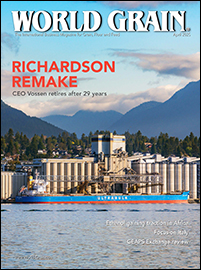 |
Once all of the ingredients have been weighed up in the proper amounts, the next step in the feed manufacturing process is to blend them together. This is done using some type of mixing apparatus. In this article we will look at different types of batch mixers used in the commercial and integrated feed industries.
As the word “mix” indicates, the mixing process involves blending together a group of various types of dry ingredients to form a blended product. It may also be a process where liquid ingredients may be added and blended with dry ingredients to make a homogeneous mixture of all. The uniformity of the mixed product is of extreme importance. Different methods of testing the mix uniformity or consistency have been developed.
The most common method used in the feed industry is the Coefficient of Variation (Cv). Prior to starting the mixing, a marker ingredient of known characteristic or strength is place in the mix as an added ingredient or an included ingredient in the mix. After the mixing is complete, 10 samples taken from different areas in the mixer are tested and compared for the marker characteristic or strength.
Differences in the marker character or strength between samples are then compared and the coefficient of variation based on the deviation between the samples is calculated. A mix is normally considered well mixed if the Cv is a value of 10 or less. A standard procedure for this was developed at Kansas State University and is an ASABE standard. A description of the process using salt as the marker is described in detail in Feed Manufacturing Technology V, Appendix D – Mixer Testing, published by the American Feed Industry Association.
Another factor in choosing a mixer is the length of mixing (cycle) time required to get a mix with a Cv of 10 or less. In earlier eras, mix time lengths were not important as long as the mixing was complete. Early vertical mixers often required as long as 20 minutes or more to completely mix a batch. A 4-minute mixing time was normal for single shaft horizontal mixers.
In today’s feed industry, higher production capacities and shorter mixing times are in demand. This has brought about new designs for horizontal mixers and the introduction of the twin shaft mixers with mix times of as little as 30 to 60 seconds.
Before discussing different types of mixing actions and mixers, it is important to review mixer capacities. Most often mixer capacities are described by the weight of the batch size being mixed in the mixer. Thus, a “4-ton” mixer supposedly mixes a 4-ton batch of feed. This is somewhat true if the density of the mixture is 40 pounds per cubic foot. But a mixer is not a scale. Its actual capacity is measured by the cubic volume of a mixture it will hold and mix properly. Thus, a 4-ton batch with an average density of 40 pounds per cubic foot requires 200 cubic feet of volume in the mixer to handle the batch.
If the average density of the batch is only 30 pounds per cubic foot, the 200-cubic-foot mixer will only hold and mix a 3-ton batch. Likewise, if the batch has an average density of 60 pounds per cubic foot, that same 200-cubic-foot mixer will hold a 6-ton batch. Most mixers used in commercial feed manufacturing are built strength-wise for mixing batches with maximum densities of 40 to 50 pounds per cubic foot. Heavier constructed mixers are available and should be specified when choosing mixers to mix higher density batches such as minerals or premixes.
Dry ingredients should be introduced into a mixer in the following order: ground grains and other major ingredients, minor ingredients, and finally, low inclusion or hand-added ingredients. These ingredients are then mixed until fully mixed (dry mix time) and the liquids are added to the mixture and the batch mixed further until fully mixed (wet mix time). There are basically three types of mixing actions available in commercial feed mixers: shearing, tumbling and cross-flow styles.
Vertical Mixers
Vertical mixers are still used in small on-farm operations but seldom found in today’s commercial feed industry. The ingredients were put into the mixer at floor level and mixed by elevating the materials to the upper part of the mixer housing by vertical augers.
From the top of the auger tubes, the materials fell by gravity down to the bottom of the mixer where they were again picked up by the vertical augers and carried back to the top for another cycle. Differences in ingredient densities, particle sizes and particle shapes caused the mixes to separate when falling from the top back to the bottom of the mixer.
For some ingredients it was very difficult to get the batch completely mixed. Additionally, some of the ingredients were difficult to pick up by the vertical screws and remained in the bottom of the mixer unmixed.
Horizontal Mixers
A majority of the mixers used in the commercial and integrated feed industry are the horizontal style. There are three basic styles of horizontal mixers: ribbon, paddle and twin shaft. These mixers are enclosed in round bottom housings.
The single shaft horizontal mixer has been used for years in feed manufacturing. It consists of a horizontal center shaft with two or more rows of opposing ribbons mounted on support arms.
The mixing action occurs as one set of ribbons move the material one direction and the other row pushes the material in the opposite direction. This creates a shearing and blending action.
A second type of single shaft horizontal mixer uses a single horizontal center shaft with arms with paddles mounted on them extending from the shaft. These mixers are available with different shapes and configurations of the paddle surfaces.
This type of mixer is primarily used for blending hard to handle or abrasive ingredients, or mixes with large additions of liquid ingredients. These mixers also create a shearing movement and blending, but also add a lifting movement to action.
The most commonly used mixer in new construction or remodeling is the newer twin shaft horizontal mixer. In these mixers there are two side-by-side counter rotating ribbon or paddle assemblies similar to placing two single shaft mixers in the same housing. These mixers have the mixing advantages of a single shaft mixer with the added ability to cross mix the ingredients between each of the assemblies.
If paddles are used, they can be overlapped to create a fluidizing zone between the two shaft assemblies. These mixers have the advantage of both lengthwise mixing as in the single shaft type and cross mixing between the assemblies.
These combined mixing actions provide for full or complete mixing in as little as a minute or less depending on the ingredients being used.
Single shaft horizontal mixers are designed to be full for proper mixing action. This means that the mixture should fill to the point that the top of the ribbon or paddles is covered. If they are overfilled, the materials above the ribbon or paddle tips do not get mixed well and often just float on top of the mixing action.
The twin shaft horizontal mixers, due to their cross mixing actions, can properly mix batches that fill only a portion of the mixer volume. This works nicely for mixing various size batches in the same mixer. In some cases, using a twin shaft horizontal mixer, the batch size can be as small as 10% to 20% of the full mixer capacities.
Drum Mixer
Another mixer is the drum type. It is a horizontal cylinder turned by an external drive. There are no rotating internal parts. The mixing is done by a series of vanes attached to the interior surface of the drum. As the drum rotates, these vanes cause a free-fall action that folds, divides and combines the ingredients into a uniform mix that is blended by the constant rotating motion. Without internal moving parts, the mixer is able to gently mix breakable ingredients or materials such as flaked grains. It also is able to mix hard to handle ingredients due to its mixing action.
This mixer is charged and discharged through openings located high on the front (end) of the drum. Liquids may be added by spraying the liquid onto the tumbling ingredients using a liquid addition accessory. The drum uses much less energy than the standard horizontal or vertical mixer as no rotating shafts are used internally. This mixer can also do small batches.
When liquids are added into any mixer, they must be sprayed into the mix so they actually are sprayed on to the ingredients and not on to the surfaces of the mixer itself. For batch mixes, it is best to limit the amount of liquid added to no more than 4% maximum of the batch weight, but higher liquid addition rates are often possible in horizontal paddle mixers and drum mixers.
Summary
When choosing a batch mixer, it is important to know the types and characteristics of materials to be mixed, the amount(s) of liquids to be added in the mixture during mixing, the sizes of batches required, and the time available for the mixing operation to meet production requirements.
It is wise to look at different mixer manufacturers and options before deciding on the correct batch mixer for your needs. Most manufacturers will gladly run a test for you to confirm the suitability of their equipment.
In a future article we will look at continuous mixing system equipment.
Fred Fairchild is feed science professor emeritus in the Department of Grain Science and Industry at Kansas State University. Prior to coming to Kansas State in 1994, he worked in the industry designing, constructing and commissioning numerous mill facilities. He is a licensed professional engineer. He can be reached by e-mail at fjf@k-state.edu.




